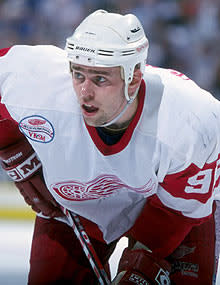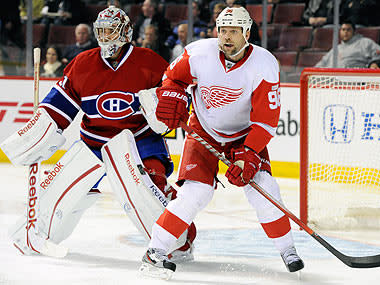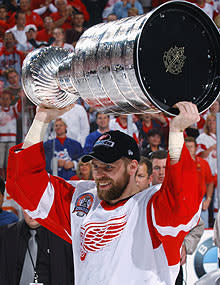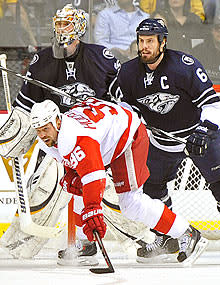Tomas Holmstrom's unlikely journey to 1,000 games
DETROIT – Of all the hilarious Tomas Holmstrom stories, the most famous is the one about his number.
In March 1998, late in his second season with the Detroit Red Wings, Holmstrom gave up No. 15 to newly acquired veteran Dmitri Mironov. He switched to No. 96 to honor the year he arrived in the NHL, but coach Scotty Bowman suggested something else.
The details have gotten hazy, and they depend on who you talk to. But the conversation went something like this:
"You should wear 98," Bowman said.
"What do you mean?" Holmstrom said. "Why?"
"Because that's the year you'll be going home."
Really, it was amazing Holmstrom had made it to the NHL at all. He hadn't been drafted until he was 21, and even then, he wasn't taken until the 10th round – 257th overall. He was a goofy guy from a small town in northern Sweden who could barely speak English and barely skate at a professional level.
But Bowman was kidding, and Holmstrom has had the last laugh.
It is 2012.
"I'm still here," Holmstrom said, grinning.
Holmstrom is 39 now and a four-time Stanley Cup champion. When he steps onto the ice Friday night against the Anaheim Ducks, he will become only the sixth man to play 1,000 regular-season games for the Red Wings, joining Gordie Howe, Alex Delvecchio, Steve Yzerman, Nicklas Lidstrom and Kris Draper.
He has found a home in Detroit as a humble, hard-working, self-deprecating role player, still Homer, the same goofy guy from a small town in northern Sweden.
His English has improved, but it's all relative. His accent used to be so thick that people couldn't even guess where he was from. Now at least they try. "They go, 'Are you French Canadian?' " Holmstrom said. " 'Yeah. Oui.' "
His skating has improved, too. But again, it's all relative. Holmstrom will become only the 48th man in NHL history to play 1,000 regular-season games with one team, and according to the man who discovered him, Hakan Andersson, the Wings' director of European scouting, "he's the worst skater of them all."
But that's the beauty of it. Holmstrom has reached 1,000 games the hard way – overcoming his limitations with hockey sense and heart, battling in front of the net, taking cross-checks and slashes, setting screens, tipping pucks.
Somehow.
"You ever seen his stick?" said Draper, who retired last summer and works for the Wings as a scout. "He's a left-handed shot, and it's curved right-handed."
Holmstrom doesn't wear full shoulder pads. He has shoulder caps sewn onto his suspenders, something Wings equipment manager Paul Boyer hasn't seen since Guy Lafleur. He doesn't need protection up there; he needs it where he gets whacked on his lower back and legs. Since coming over from Sweden, he has had the same plastic pieces of cut-up shoulder pads behind his calves, tied to his shin guards with skate laces.
Both of his knees need braces and regular injections of synthetic lubrication. One knee hasn't had a medial collateral ligament his entire NHL career.
"The way that he plays and the abuse that he took, you probably would have thought that his body would just give up on him," Draper said. "I think his body has given up on him, but his pain threshold is probably as high as I've ever seen."
Holmstrom said that to his body, this feels like 1,500 games.
To goaltenders, it must feel like 1,500,000.
"He's not an elite skater, yet he's an elite competitor," said Wings coach Mike Babcock. "It just goes to show you that players come in all different sizes, shapes and abilities, and Homer's managed to have a good enough package to play a long time."
* * * * *
Holmstrom's limitations have never involved desire. He received his first pair of skates as a toddler. The first time he tried them, he had to be dragged off the ice. One morning soon afterward, his parents woke up, and he was gone. They called for him. They searched for him. They called neighbors and asked if anyone had seen him.
Then they noticed his skates were gone, too.
They called the nearby outdoor rink. Yes, they were told. There is a little guy here sleeping peacefully on a bench. Holmstrom had gotten up, gone to the rink, asked someone to lace up his skates and made his way around the ice for an hour or so. Finally, he plopped down, exhausted.
Years later, his coach told the team to go home for Christmas. Two days off. No practice.
"Even though it was Christmas, he was grumpy and not very fun to have around the house," Andersson said. "The morning after, he was really grumpy. So his dad said, 'Go ahead and practice. I'm not going to tell the coach anything.' And he lit up like a Christmas tree, and out the door he went."
Holmstrom was 17 when Andersson first saw him. He was one of 30 players in his age group invited to a Team Sweden camp. He chased the puck, went to the net, fought for rebounds, never gave up. But he was small – maybe 5-foot-10, 165 pounds. He didn't make the team.
"I didn't think more of it," Andersson said. "I may have put in a little note about a little guy who played with good intensity and something like that."
A couple of years later, Andersson was chatting with a coach in northern Sweden. He asked who the best player was in his league. The coach said it was a 20-year-old named Tomas Holmstrom. The little guy had grown to 5-foot-11, 190 pounds. He was a physical player. He was known as the "Demolition Man."
Andersson went to see Holmstrom a couple of times. He put him on his list.
"Skating was an issue – still is, almost, you know?" Andersson said. "But I felt that he had pretty good hands around the net. I felt he had good sense. He could anticipate what was going on, where the puck was going to bounce, kind of. And he seemed very dedicated."
Bowman said even though the Wings drafted Holmstrom in the 10th round in 1994, Andersson told his colleagues he had a good chance to replace Dino Ciccarelli as the net-front presence on the power play.
The Demolition Man made an immediate impression when he arrived in Detroit two years later, just as the Wings traded Ciccarelli to the Tampa Bay Lightning. He almost took out The Captain.
"I think his first shift in training camp, he tried to run Stevie, and I think someone kind of had to grab him, like, 'Ooh, you don't do that,' " Draper said. " 'Never mind seeing 1,000 games, you won't see Game 1.' "
One day, the Wings were doing a drill. Bowman was yelling at Holmstrom to go faster.
"Then finally Homer says, 'Well, I'm going as fast as I can,' " Draper said. "And then Scotty's like, 'If that's as fast as you can go, we've got to get someone that can go faster.' Homer puts his head down and starts digging in. I don't think that conversation went the way he thought it was going to."
Another day, Draper was sitting in the sauna when Holmstrom came in.
"He goes, 'How do you get out of the coach's dog yard?' " Draper said. "He goes, 'I'm in it, and I can't get out.' I go, 'Homer, doghouse?' 'Doghouse. Dog yard. I'm in it!' "
But he didn't stay in it.
"You could have a lot of fun with Homer," Bowman said. "They kid him a lot. He was the butt of different jokes. But he's a pretty sharp guy. People don't think he is, but he's a real sharp guy."
* * * * *
They kid him about being sharp.
"He's obviously a pretty smart guy when he gets the puck," Draper said, setting up his punch line. "He gives it to Pav or ‘Z’ or Nick and then goes right back to the front of the net. I mean, you've got to say he's an intelligent hockey player, right?"
Ha, ha. But you don't play with stars like Lidstrom, Pavel Datsyuk and Henrik Zetterberg unless you're smart, especially if you can't skate. He has spent time on the Wings' top line with Datsyuk and Zetterberg at even strength.
"He's a smart, smart player," Zetterberg said.
Seriously.
They kid him about the goals he has erased by interfering with the goaltender.
"If you ask Nick, it's probably 50 of his goals," Holmstrom said.
They kid him about the phantom goals he has gotten.
"We always kid around with him if it goes in," Draper said. " 'Did you touch it? Did you touch it?' 'I think so. Let's check the video.' "
Ha, ha. But for all the disallowed goals and phantom goals, Holmstrom has created many more goals for his teammates. For all his screens and deflections, he hasn't gotten the credit he deserves. He should have more than his 284 career assists. He earned his 240 goals. Nearly all of them have come within a few feet of the net.
What he does is an art.
It starts with sheer will, for sure. Guys like Rob Blake and Ed Belfour used to give him beatings in front of the net. But it goes beyond will. It extends to discipline, timing, guile.
Holmstrom hardly ever loses his cool, takes a penalty and nullifies a power play. He hardly ever loses his concentration.
"Most guys are trying to find out who's cross-checking them, not worried about the puck," Babcock said. "The good guys don’t worry about getting cross-checked. They can always find the puck."
Holmstrom finds the puck at the right time. He doesn't just stand there. If he sets up too early, a defenseman could knock him out of the way or the goaltender could just look around him. So he lurks. He waits. He keeps his stick from being tied up.
After years of practicing and playing – especially with his point man, Lidstrom – he knows when the shot is coming and where it is going to go. He knows the precise moment he needs to block the goaltender's vision. He knows how to change the direction of the shot just enough, and he has the hand-eye coordination to get his stick on pucks you wouldn't expect.
"He positions himself really well in front of the goalie's eyes," said the Edmonton Oilers' Ryan Smyth, another net-front expert. "He pretty much acts as a goalie as far as moving and the angles."
"Sometimes it feels like you move over, and he's already there," said Oilers goaltender Nikolai Khabibulin. "The shot already comes, and you have no time to do anything. I think it's a talent. Even if the pucks are going wide, you still cannot relax with him, because sometimes he still gets his stick on it and he brings the puck back towards the net. When he's there, especially on the power play, you can never relax."
Holmstrom knows his enemies, too. Bowman, now a senior advisor for the Chicago Blackhawks, watched the Wings play the St. Louis Blues recently. Jaroslav Halak was deep in his crease. Holmstrom backed in, touched him and came out. Halak, a hothead, got upset, came out and pushed Holmstrom.
"Now he was out of the crease, and then the shot came," Bowman said. "The goal went in."
Pretty sharp.
* * * * *
Holmstrom has adapted well through the years.
Some rule changes have helped him. He doesn’t have to worry about leaving his pinky toe in the crease anymore, and defensemen and goaltenders can't hack him as much as they used to.
Some of the rule changes have challenged him, but he has risen to that challenge. The crackdown on obstruction after the 2004-05 lockout led to more speed and more penalties. You'd think Holmstrom would have been left behind at even strength, able to survive only on the power play. But look at the numbers: In the two seasons before the lockout, Holmstrom scored 35 goals, 18 of them (51.4 percent) on the power play. In the two seasons afterward, Holmstrom scored 59 goals, 24 of them (40.6 percent) on the power play.
The third season after the lockout, he averaged 17:33 of ice time in the regular season and 17:10 in the playoffs, both career highs. The fourth season after the lockout, a guy who used to be minus-12 was plus-18, another career high.
In other words, Holmstrom raised his all-around game, at least at his peak. Asked how much he had improved his skating, he cracked: "I wonder." But he said he felt he had proven a lot. He cut his weight from a high of 220 to about 200 and kept it there. He did whatever he could.
"If I didn't turn out to be a better skater, I don't think I would be able to play. Even if I'm not a good skater, I get there," Holmstrom said. "You've got to work on your game all the time. There are young, good, fast kids coming up all the time. They want to take your spot."
Holmstrom would love to keep his spot for the foreseeable future. He would love to keep driving to the rink every home game with Lidstrom.
But his contract expires after the season, and his body has taken a lot of wear and tear. His knees are grinding bone on bone. He doesn't do any jumping because the pounding is too much. Sometimes he can't run.
When he took shots of lubricant in both knees during the all-star break, he suffered a bad reaction and had to sit out a game. He probably will need surgery after he retires so he can run, ski and play tennis, so he can enjoy an active life.
"It's going to be a big decision for sure," Holmstrom said. "We'll decide after the season."
Eventually his number will be up. But whenever it is, it will be a long way from '98, and his legacy will be this:
Sometimes what you can do outweighs what you can't.
"As a scout, you have to evaluate every player individually," Andersson said. "They have some good things and some bad things. Tomas Holmstrom, you know what I mean?"
More sports news from the Yahoo! Sports Minute:
Other popular content on Yahoo! Sports:
• Facebook campaign to get Will Ferrell for NBA All-Star intros
• T-shirt jinx levels unbeaten Murray State basketball team
• Have you criticized Miami Marlins star Hanley Ramirez on Twitter?




